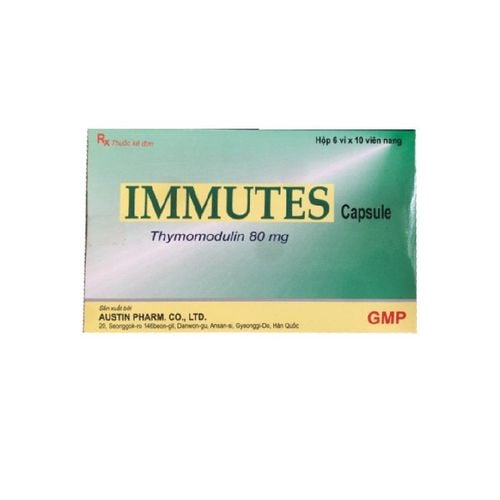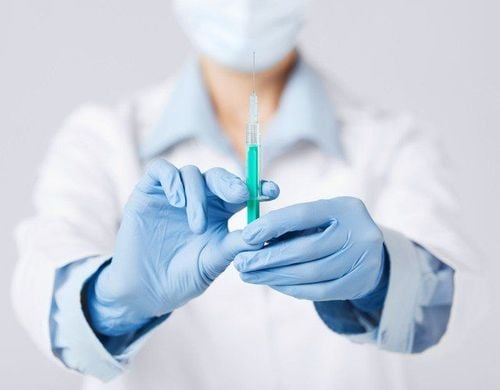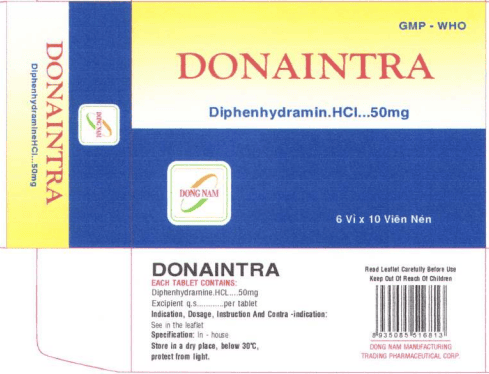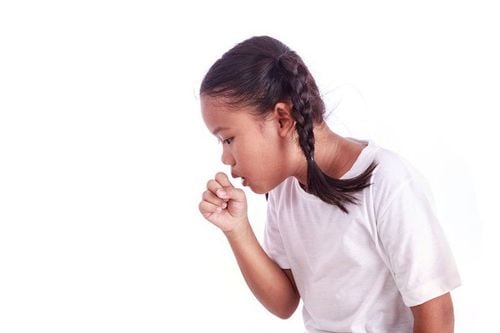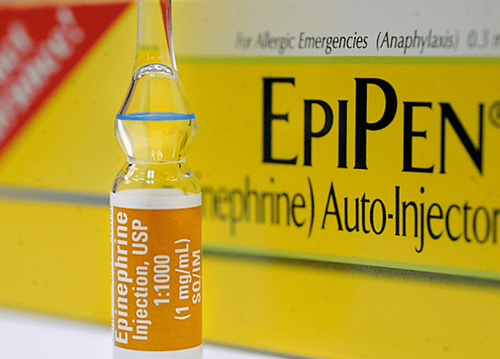This is an automatically translated article.
Anaphylaxis is one of the dangerous conditions that can be encountered when children are exposed to foreign allergens. This condition can lead to short-term anaphylaxis and death. Therefore, parents need to know how to recognize the symptoms of anaphylaxis and how to prevent them.
1. What is anaphylaxis?
Anaphylaxis is a rapid and severe allergic reaction, and one of the scariest health emergencies a parent can face. When a child goes into anaphylaxis, immediate medical attention is needed.
Anaphylaxis begins when the immune system mistakes a relatively harmless substance (allergen) as a serious threat, triggering the release of histamine and other chemicals that cause some of the symptoms of the reaction. protection - some of which can be life-threatening.
Sadly, anaphylaxis seems to be on the rise in children. So being aware of a serious allergic reaction and what to do if it occurs can save a child's life.
Sometimes people call anaphylaxis anaphylaxis. Both are the result of a severe allergic reaction, but they are not quite the same. When a child has anaphylaxis, their blood pressure will be unstable and they may feel dizzy or faint. Anaphylaxis can lead to anaphylaxis, but not always.
2. Can babies have anaphylaxis?
Yes, but it's not common in babies under 6 months. That's partly because babies haven't been exposed to many allergens, especially food allergens. In general, more than one allergen exposure is required for a reaction to occur, and it can take years for some allergies to develop.
However, anaphylaxis has been reported in infants less than 1 month of age and in infants with no prior exposure to the allergen.

Trẻ sơ sinh có thể gặp tình trạng sốc phản vệ
3. Signs and symptoms of anaphylaxis in infants and children
Symptoms of anaphylaxis in infants and children may include:
Swelling of the skin, lips, throat, tongue, or face Wheezing or severe breathing problems Fast or weak pulse, or heartbeat irregular hives or rash Skin flushing Dizziness, fainting, loss of consciousness Nausea, vomiting, stomach cramps, diarrhea Extremely pale skin, sweating or blue skin Confusion, stuttering Infants You may also experience:
Anger or crying for no reason Sudden drooling Unusual sleepiness
4. How quickly does anaphylaxis occur in infants and children?
The symptoms of anaphylaxis can appear anywhere from seconds to hours after a child is exposed to the allergen. For example, food-borne anaphylaxis usually occurs within 30 minutes, while a severe allergic reaction to an insect sting usually occurs within seconds or minutes.
5. What causes anaphylaxis in infants and children?
There are many possible allergens, but these are the most common:
Food. This is the most common cause of anaphylaxis in children. The top trigger foods are: peanuts and tree nuts (such as walnuts and cashews), shellfish (such as shrimp and lobster) and fish, cow's milk, and eggs. Drugs in the penicillin family, including the common antibiotic amoxicillin. Insect bites and stings, especially from wasps, honey bees, yellow bees, wasps, fire ants, and reaper ants. Rubber. This is a commonly used material in medical facilities. Food preservatives and colorants.
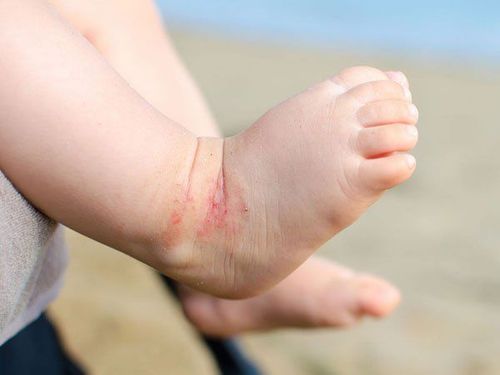
Côn trùng cắn có thể gây tình trạng phản vệ ở trẻ nhỏ
6. What should I do if my child has anaphylaxis?
If your infant or child shows signs of a serious allergic reaction, especially if he has trouble breathing or changes consciousness:
Call 911 immediately (If you have an epinephrine auto-injector, use this syringe first). Lay the child down with his legs elevated to reduce the risk of shock. Try to keep your child calm by talking to them. Do not give your child any medicine if they have trouble breathing or swallowing, as this poses a choking hazard.
7. How is anaphylaxis in infants and children treated?
When paramedics arrive, they will likely treat the child locally with an injection of epinephrine to stop the reaction within minutes. Epinephrine makes the heart beat harder, relaxes muscles throughout the airways, reduces swelling, and improves tone in blood vessels to increase blood flow to vital areas like the heart and brain.
The medical staff will take the child to the hospital, where the child will be examined, treated and monitored for slow reactions. Some children will receive intravenous fluids, oxygen, or repeated doses of epinephrine. Doctors at the hospital can help you determine what's causing the problem, although sometimes a specific cause can't be identified.
Before your child is discharged from the hospital, you should get a prescription for an epinephrine auto-injector (usually an EpiPen). Make sure you understand how to use the auto-injector before you leave the hospital. You'll want to follow up with your child's doctor, who will likely refer you to a pediatric allergist for further testing and follow-up care.
8. What infants and children are at risk for anaphylaxis?
Any child can develop anaphylaxis, but some children are at higher risk. Your child is more likely to have a serious allergic reaction if he or she:
Asthma Allergies Family history of anaphylaxis Have had anaphylaxis in the past

Trẻ bị suyễn khả năng cao bị phản vệ
9. What can you do to prevent anaphylaxis in children?
Avoid known allergens. If you know your child is allergic to something, avoiding everyday allergens is the best prevention.
Control your child's asthma. Talk to your doctor about getting your child's asthma under control as much as possible to reduce the severity of breathing difficulties during an allergic reaction.
Read food labels. If your child is allergic to certain foods, it may only take a small amount to trigger a reaction, so it's important to read labels carefully and ask restaurants or friends if the meal contains: any item is limited or not. You need to be vigilant about this for your child until he can do it on his own.
If insect stings or stings cause trouble, help your child find insect-free play places. Don't rely on bug sprays - they don't repel bees and fire ants, which often sting children. Also, don't let your child run barefoot outside. Many children are stung when they accidentally step on an insect sting or bite.
Carry an epinephrine auto-injector. If your child has had a severe allergic reaction, your doctor will likely recommend carrying a pen-like injector that contains epinephrine, such as an EpiPen Jr.
This drug is available by prescription. You should carry two epinephrine auto-injectors with you as your child may need two doses. Develop an emergency plan with your doctor in advance so you know exactly what to do when an autoinjector is needed. Rest assured that epinephrine is very safe and should be used whenever an allergic reaction is suspected.
Also, make sure that anyone who cares for your child - caregivers, daycare workers, loved ones - knows about your child's allergies, how to recognize an allergic reaction, and exactly what to do. if the child has it. You may need to get detailed instructions from your child's doctor to share with your child's nursery or preschool provider.
Wear a medical alert bracelet. Once a child has a severe reaction such as anaphylaxis, you should wear a medical alert ID bracelet (available online or in most pharmacies), as this can alert providers. health care of the child's condition in the event of an emergency.
Introduce children to foods that cause allergies early. Doctors used to recommend delaying the introduction of allergenic foods in children at higher risk of developing allergies. However, current research suggests that delaying the introduction of allergenic foods may actually increase the risk of food allergies.
Today, experts recommend introducing commonly allergenic foods as soon as your baby is ready to grow with solids and has tolerated some other typical first foods like meat, fruits and vegetables. However, if you have a family history of food allergies, talk to your child's doctor or nurse first.

Cha mẹ có thể cho trẻ tiếp xúc với thực phẩm gây dị ứng từ sớm
When there are initial signs of an allergy, you should immediately go to a reputable medical facility for timely examination and treatment, to avoid severe allergic reactions causing anaphylaxis and other dangerous complications. .
Vinmec International General Hospital is a leading high-quality medical unit in Vietnam, with a team of highly qualified, well-trained, professional domestic and foreign doctors and experienced doctors. , conscientious. The system of advanced, new and modern medical equipment is imported from Japan, the US, Korea, the Netherlands... on par with major hospitals in the region and in the world. Treatment techniques are updated regularly and continuously to bring patients the most effective regimens.
Please dial HOTLINE for more information or register for an appointment HERE. Download MyVinmec app to make appointments faster and to manage your bookings easily.
Article referenced source: babycenter.com



